The kind and laid-back nature of the bearded dragon is well-known. It will sometimes wave at you in such a manner that you will grin and wave back.
For most pets, communication is essential. Your beardie is also communicating with you via body language. There are a few possible reasons for your bearded dragon waving. While more research is needed to fully comprehend the infamous bearded dragon wave, here are some fantastic instances to help you grasp what’s going on in their mind and how to cope with it.
Major reasons why a bearded dragon may wave
It shows submission to its owner
When the dragon waves, it is often assumed that they are demonstrating surrender. It conveys a sense of acceptance and passivity that indicates, “You’re in control, and I’m okay with that.” And sure, it does seem to be that way.
They are not an animal that will go toe-to-toe with anything larger and tougher, given their already docile and mild character.
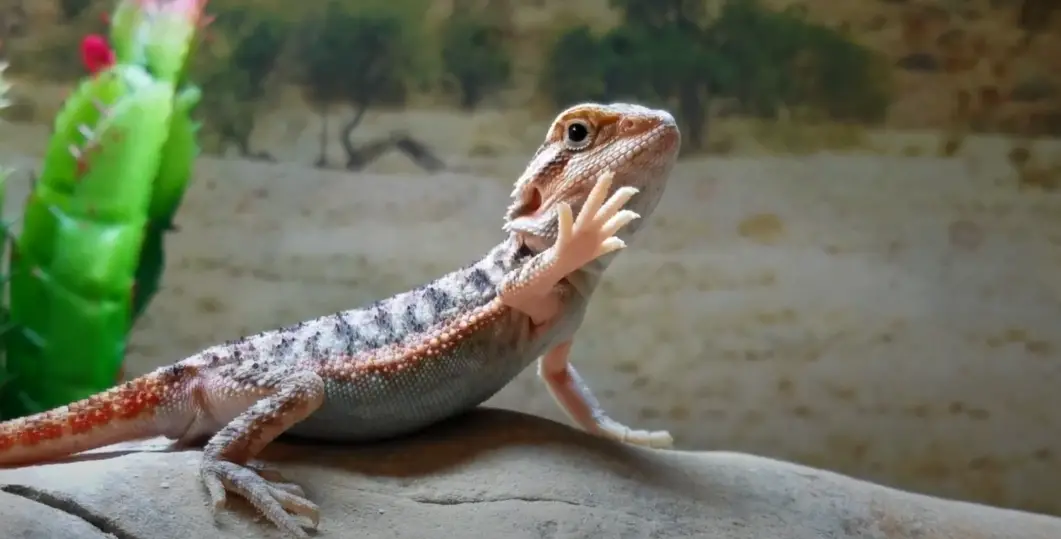
A bearded dragon isn’t like your average Chihuahua, who will howl at the feet of a German Shepard any day to show them who’s in charge. Your reptile should be ok once they recognize they are the smaller creature. They don’t mind admitting that they aren’t the room’s alpha.
They are, once again, quite responsive to their owners. Basically, people recognize you as the boss. You’re larger, you look after them, and you have the most of their day under your control.
Possibly your tiny beardie is merely demonstrating his or her appreciation to you and indicating that they will surrender because of their kind nature and awareness of what you offer for them.
When individuals walk into a room, they usually notice the waving. In many respects, it’s welcome for most people. But for them, it’s a step farther, more akin to a respectful bow. It is especially common among tamed pets.
It is afraid of other pets in the house
Arm-waving may be a positive or negative method of communication. It’s possible that your beardie is terrified, which is why he’s waving so much. If this occurs regularly, try a few things out with other pets to ensure your reptile isn’t afraid.
It’s generally known that bearded dragons do best when kept apart from one another since things may and do go wrong at any time. This is most likely the reason for your dragon’s persistent waving if you have more than one beardie in the same tank. Please read my post on how to maintain numerous bearded dragons together for more details.
Even if your beardie is alone in the tank, other pets that he or she sees often might be making an impact. Keep an eye out for the waving. If it occurs while another animal is around, it might indicate that your beardie is afraid.
They comprehend that there is a bigger animal in their midst, similar to surrendering to their master, but this time it is more about terror. They are aware that you will not harm them. It’s normal for them to feel afraid, for example, when they see your dog leaping in through the entryway.
Your beardie may not realize that a bigger animal is the cutest, nicest, and most affectionate animal you’ve ever seen. So, this is their method of demonstrating that they will be obedient, but they are most likely also afraid. Consider them raising a white flag instead of their hand in this case.
How to calm a scared bearded dragon? Provide a separate area for each pet that is out of reach of the others. Maybe put something in a corner that they can claim as their own, so they know it’s their safe space. A bearded dragon may hide behind a variety of natural objects in its natural environment. Try recreating this in their tank for them. Consider how some things may protect them and provide refuge when they are startled or terrified.
A little plant or a piece of wood that seems trivial as an aesthetic ornament might offer a haven for your bearded dragon. You may purchase a variety of wonderful constructions that will provide them with enough space ideal for smaller lizards.
Small logs, twigs, and pebbles are all fantastic methods to make them feel comfortable if you’d like to use a natural approach. Just be careful to sanitize everything you bring in from the outside since it might contain deadly parasites or germs.
It greets other pets or animals
It’s possible that your bearded dragon is merely noting the existence of another pet in your house rather than expressing fear.
Arm waving is a common behavior among bearded dragons when they are in the company of other bearded dragons. However, it might simply be their method of recognizing that animal’s existence in a non-fearful manner with other kinds of animals.
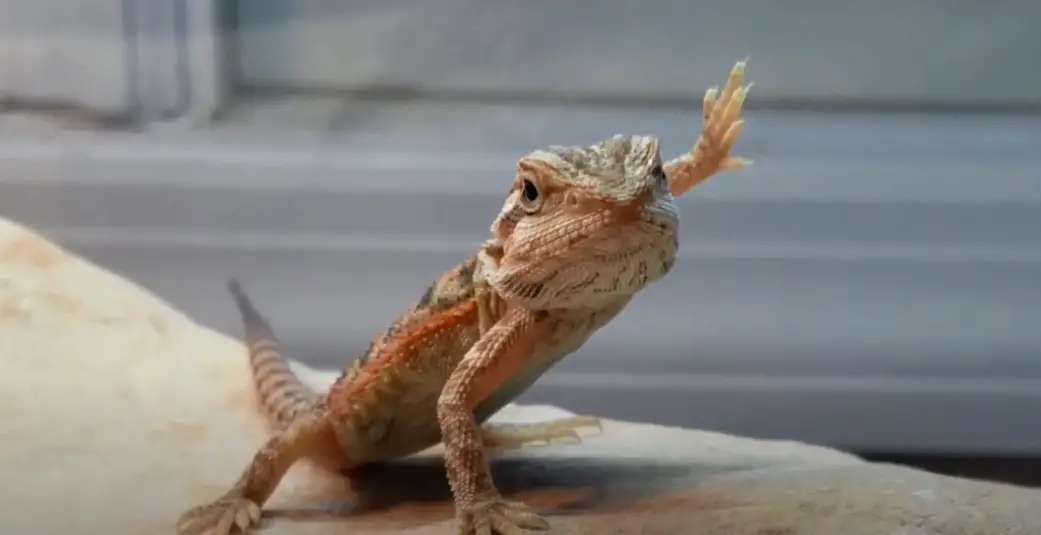
It might be difficult to tell if your bearded dragon is waving in reaction to something that seems to be reasonably innocuous or when they are experiencing an imminent catastrophe. There is, however, one important indication you may look for to assist you to figure out which one it is.
Is it possible for them to be seen after waving? If they don’t attempt to hide while another pet is around, it might just be their way of demonstrating that they are aware of the other pet’s existence. If they quickly hide behind a plant, this is clearly a symptom of anxiety.
It is confused by own reflection
You may sometimes observe your beardie waving for no apparent reason. Despite the fact that no humans or pets have visited the area in a middle time, your bearded dragon starts peering towards the distance and waving. Don’t worry, your small pal hasn’t fully lost his mind.
This may be the solution if you have a terrarium made of glass or plastic with a reflecting surface. Their mirror is most likely perplexing them, prompting anxiety and/or a desire to recognize the existence of “another bearded dragon”.
For bearded dragons, the “imaginary intruder” phenomenon is quite widespread. Other behavioral abnormalities might result, such as regular hiding, running back and forth, or clawing at the glass, commonly known as “glass surfing”.
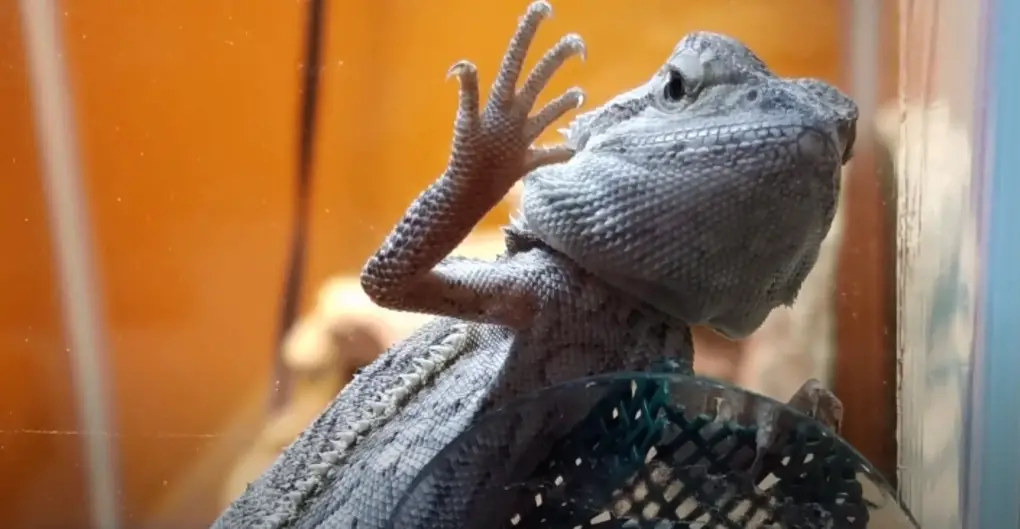
Sadly, there are a variety of different reasons for most of these habits, ranging from their environment being too hot or tiny to just wanting to go out and explore. If you see these other behaviors but not the waving, you may need to investigate more to figure out why.
If the waving is caused by their seeing their reflection, you may observe them waving more at particular times of the day. This is most likely due to variations in illumination when the sun travels across the sky and/or artificial lighting is turned on and off.
You may take steps to reduce the reflection of your bearded dragons. Moving decorations closer to the enclosure walls or using a terrarium backdrop to cover as much as three sides of the enclosure will assist.
If all else fails, try moving the vivarium to a corner of the room where the neighboring walls are brighter. This will also aid in the reduction of reflections inside the tank.
It waves to its couple
If your beardie has seen someone they like, arm-waving may go hand in hand with a few additional habits. This is especially frequent in female beardies, who may wave to attract the attention of male beardies who may be puffing or acting in various ways. This is their method of expressing their availability, acknowledgment of the other reptile, and readiness to mate.
While this isn’t the most typical explanation, it’s crucial to pay notice when your lizard is in the presence of another of the same sex. Waving is likely to happen if they get horny since the female is indicating that she is willing to surrender.
It needs another place to live in
A tank that is too small for your beardie might make them scared and cause excessive waving.
There are a variety of reasons why a dragon would consider their surroundings to be dangerous, and regrettably, most of them can be rectified with a little troubleshooting and determination:
- The size of the tank. Your beardie’s safety may be jeopardized due to the size of the tank in which it is kept. It may make them feel confined or contained if it’s too tiny, and it may make them feel exposed or vulnerable if it’s too wide with too many open areas;
- The window view. Is your bearded dragon able to look out the window? If this is the case, they could be seeing birds, which are their natural predator, making them fearful. If this is the case, consider repositioning their tank or covering the window with a towel or cloth;
- The habitat lacks hidden spots. Is the space in your bearded dragon’s habitat limited? Have you made sure they have ample hiding places? Bearded dragons in the wild will shelter in holes in the earth to protect themselves from predators or bad weather. If your beardie is scared or endangered, its natural tendency is to seek shelter, and if you haven’t offered enough alternatives, your dragon may get agitated;
- The tank lacks natural surroundings. Your bearded dragon’s environment should be as near to its natural environment as possible. Study the setups of other pet owners as well as the bearded dragon’s natural environment. This will assist in making your beardie feel at ease in its tank rather than out of place in its surroundings;
It wants to stay alone
Bearded dragons are typically solitary creatures that do not like sharing their tanks with other bearded dragons. Although it may sometimes work, it is more likely that one will be more dominating than the other pet.
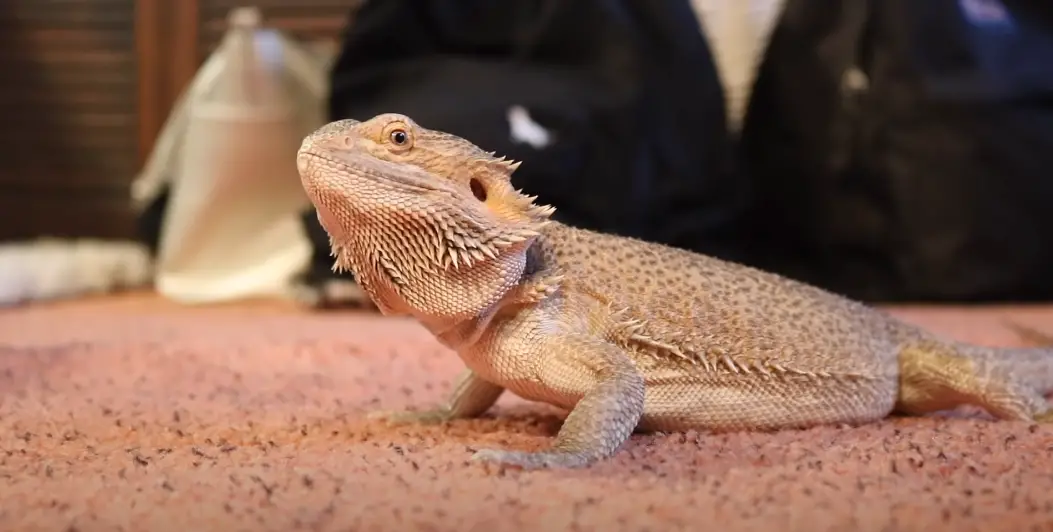
This may induce the less aggressive pet to wave as a sign of submission. This kind of circumstance is unhealthy for your pets since it implies that one (or both) of them is agitated. As a result, they should be kept separate in tanks.
FAQ
Should you stop a beardie from waving an arm?
No. Arm-waving is a deeply embedded and natural activity in bearded dragons, therefore halting one would be almost impossible. It’d be like trying to stop a dog from wiggling its tail.
Depending on why your beardie is waving its arms, you may be able to make adjustments. If you are able to make improvements to your surroundings, you may see less arm-waving.
You should expect less arm waving if you withdraw other lizards from their tank because they’re being bullied and then put them in tanks that are set up for them to flourish.
Do male bearded dragons arm-wave or just females?
A few misinformed individuals have perpetuated the myth that only female bearded dragons can wave. This might be due to the fact that females are the ones that start the waving when it refers to mating behavior.
Male and female beardies will both wave, so don’t be fooled. All of the other possible motivations for waving are common for both genders, except for mating behavior.
Is it normal if your pet never waves?
It’s likely that your pet isn’t fond of the whole waving thing. And that’s just alright. Some novice bearded dragon owners mistakenly believe that all bearded dragons wave, and that their pet’s lack of it indicates a problem. In actuality, this does not imply that they are in any way defective. They don’t think it’s necessary to wave.
Is the arm-waving of a bearded dragon the same as a greeting?
A waving bearded dragon isn’t saying “hello”, as adorable as it may seem. Waving is a clear gesture that these reptiles have been using for a long time, long before they were regarded as suitable pets. They’re merely attempting to fit in a controlled environment. When used to signal they recognize your presence or power, waving comes closest to expressing “hello”.
Is the arm-waving of a bearded dragon something unhealthy or disturbing?
Bearded dragons are incredible reptiles with remarkable habits that set them apart. Evolution has given them these habits for a cause, so it’s only normal that they employ them. Nevertheless, arm-waving is one of those behaviors that should be observed only on rare occasions.
Every reptile, mammal, and even human being may experience fear or aggression at some time, and arm waving is a common pet’s response.
What you don’t want is a scenario in which the beardie is continuously intimidated. This isn’t healthy for them. This kind of circumstance might lead to increased stress and disease.
Their appetite may be suppressed as a result of the stress, and they may refuse to eat. This is clearly not ideal, particularly for young reptiles that are still developing quickly and need as many nutrients as possible.
You’ll have to decide if the arm-waving occurs sometimes and it is alright, or whether it occurs often and has to be addressed.
What to do if the bearded dragon waves too often?
If your beardie is always waving, there is most likely a problem that has to be addressed. If your bearded dragon feels at ease, any waving will most likely occur seldom rather than on a regular basis. When they’re bothered by anything, you’ll see this happening a lot more.
Waving will definitely happen more often if your reptile is continuously terrified of humans or animals passing by their enclosure. Living in a continual state of tension isn’t good for your beardie, and it might lead to long-term health issues (it may also end with a bite).
To fix this, do all you can to decrease external sources of stress or worry. Place its cage in a secure spot where it will be unaffected by other people or animals until the beardie feels more at ease (which may never occur).
You need to assess the tank’s setup to see whether the problem is due to a substandard environment. Is there enough space in the enclosure? Is there a problem with the temperature, humidity, or lighting? Is there a suitable hiding spot?
To assess whether you can improve, be objective and honest with yourself. This will help you to fix whatever is upsetting your beardie and driving them to wave constantly.
Tips for pet owners: if you have recently installed new equipment, check your current hygrometer, thermometer, and thermostat. It’s possible that they’re not suitable for your beardie.
Final thoughts
If you’re concerned that your beardie is waving for reasons you don’t understand, give your local vet a call to see if they know anything you don’t. However, trial and error should help to figure out what’s generating the arm-waving without resorting to harsh methods. Because each beardie is unique, it’s possible that yours is more likely to notice the other animals in your habitat.

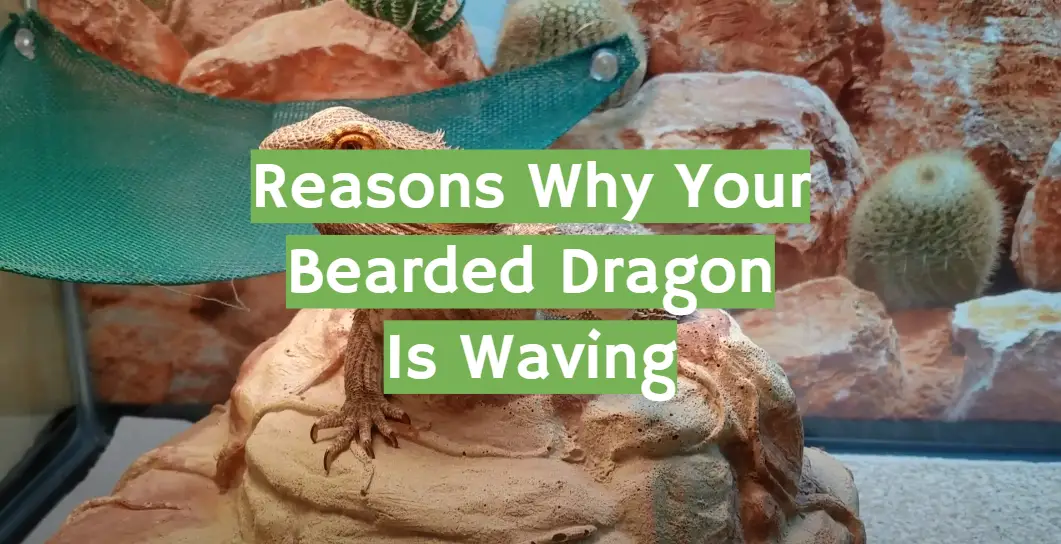
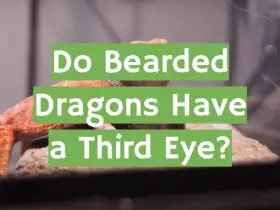



Leave a Review